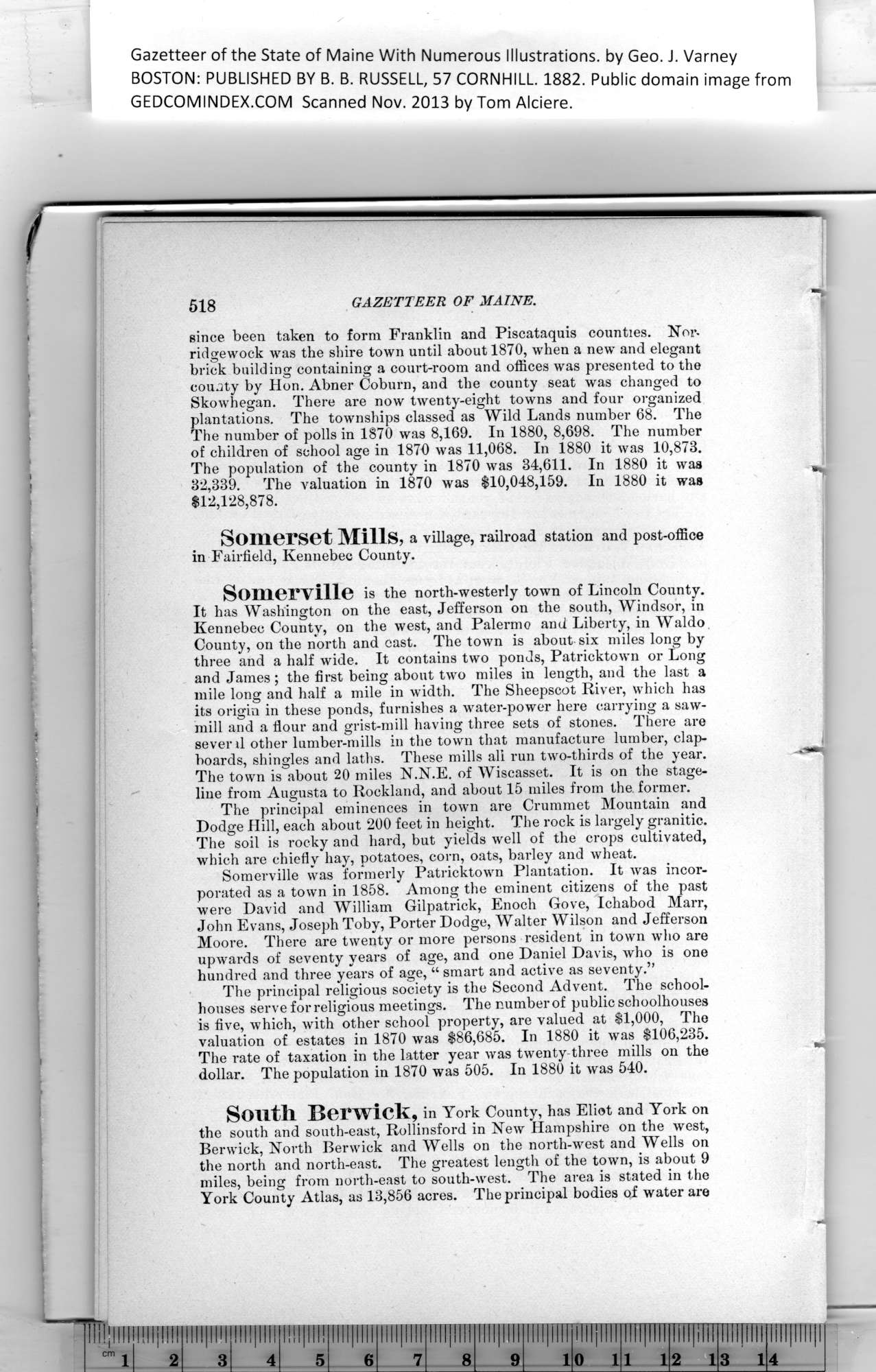|
Gazetteer of the State of Maine With Numerous Illustrations, by Geo. J. Varney
BOSTON. PUBLISHED BY B. B. RUSSELL, 57 CORNHILL. 1882. Public domain image from
518 GAZETTEER OF MAINE.
since been taken to form Franklin and Piscataquis counties. Nor-
ridgewock was the shire town until about 1870, when a new and elegant
brick building containing a court-room and offices was presented to the
county by Hon. Abner Coburn, and the county seat was changed to
Skowhegan. There are now twenty-eight towns and four organized
plantations. The townships classed as Wild Lands number 68. The
The number of polls in 1870 was 8,169. In 1880, 8,698. The number
of children of school age in 1870 was 11,068. In 1880 it was 10,873.
The population of the county in 1870 was 34,611. In 1880 it was
32,339. The valuation in 1870 was $10,048,159. In 1880 it was
$12,128,878.
Somerset Mills, a village, railroad station and post-office
in Fairfield, Kennebec County.
Somerville is the north-westerly town of Lincoln County.
It has Washington on the east, Jefferson on the south, Windsor, in
Kennebec County, on the west, and Palermo and Liberty, in Waldo
County, on the north and cast. The town is about six miles long by
three and a half wide. It contains two ponds, Patricktown or Long
and James; the first being about two miles in length, and the last a
mile long and half a mile in width. The Sheepscot River, which has
its origin in these ponds, furnishes a water-power here carrying a saw-
mill and a flour and grist-mill having three sets of stones. There are
sever il other lumber-mills in the town that manufacture lumber, clap-
boards, shingles and laths. These mills all run two-thirds of the year.
The town is about 20 miles N.N.E. of Wiscasset. It is on the stage-
line from Augusta to Rockland, and about 15 miles from the former.
The principal eminences in town are Crummet Mountain and
Dodge Hill, each about 200 feet in height. The rock is largely granitic.
The soil is rocky and hard, but yields well of the crops cultivated,
which are chiefly hay, potatoes, corn, oats, barley and wheat.
Somerville was formerly Patricktown Plantation. It was incor-
porated as a town in 1858. Among the eminent citizens of the past
were David and William Gilpatrick, Enoch Gove, Ichabod Marr,
John Evans, Joseph Toby, Porter Dodge, Walter Wilson and Jefferson
Moore. There are twenty or more persons resident in town who are
upwards of seventy years of age, and one Daniel Davis, who is one
hundred and three years of age, “ smart and active as seventy.”
The principal religious society is the Second Advent. The school-
houses serve for religious meetings. The numberof public schoolhouses
is five, which, with other school property, are valued at $1,000, The
valuation of estates in 1870 was $86,685. In 1880 it was $106,235.
The rate of taxation in the latter year was twenty-three mills on the
dollar. The population in 1870 was 505. In 1880 it was 540.
South Berwick, in York County, has Eliot and York on
the south and south-east, Rollinsford in New Hampshire on the west,
Berwick, North Berwick and Wells on the north-west and ^Wells on
the north and north-east. The greatest length of the town, is about 9
miles, being from north-east to south-west. The area is stated in the
York County Atlas, as 13,856 acres. The principal bodies of water are
PREVIOUS PAGE ... NEXT PAGE
This page was written in HTML using a program written in Python 3.2
|
